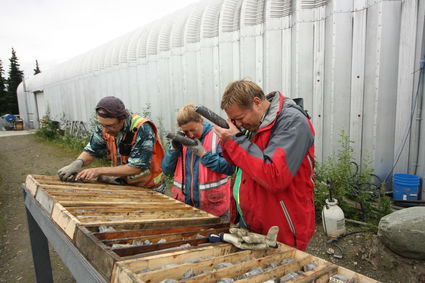
Trilogy Metals Inc. Nov. 19 reported additional copper-cobalt results from drilling beyond the deposit at Bornite, a part of the company’s Upper Kobuk Mineral Projects in the Ambler Mining District of Northwest Alaska.
According to a 2016 calculation, the open-pit deposit at Bornite contains 40.5 million metric tons of indicated resource averaging 1.02 percent (913 million pounds) copper; and 141.9 million metric tons of inferred resources averaging 1.74 percent (5.45 million lb) copper.
The deposit also hosts 182.4 million metric tons of inferred resource averaging 0.019 percent (77 million lb) cobalt, according to a resource calculated for the battery metal earlier this year.
This overall resource consists of a near surface resource amenable to open-pit mining and a deeper and higher grade resource currently considered an underground deposit.
The underground portion hosts 57.8 million metric tons of inferred resource averaging 2.89 percent (3.68 billion lb) copper and 0.025 percent (32 million lb) cobalt.
Last year, Australia-based South32 Ltd. funded a US$10-million drill program that involved wide-spaced holes aimed at identifying just how much further north the underground portion of Bornite extends. With the northernmost holes all tapping high-grade copper, this drilling did not close off mineralization to the north but did demonstrate the underground portion of Bornite covers at least a 1,500- by 2,500-meter area north of the resource.
This year, South32 funded another US$10.8 million of drilling that involved another 12 holes at Bornite, eight of which were targeted to infill the 300- to 400-meter spaced holes drilled in 2017, with the goal of bringing a portion of this expansion area into the Bornite resource.
The latest round of results is from three holes drilled in the northern resource expansion area.
• RC18-0248, drilled in the western part of the resource expansion area, cut five mineralized intervals: one meter averaging 14.38 percent copper and 0.03 percent cobalt; 21.3 meters averaging 1.73 percent copper and 0.01 percent cobalt; 21 meters averaging 0.93 percent copper an 0.01 percent cobalt; 15.1 meters averaging 1.32 percent copper and 0.01 percent cobalt; and 4.9 meters averaging 2.97 percent copper an 0.08 percent cobalt.
• RC18-0249, drilled about 1,000 meters east-southeast of RC18-0248, cut 38.3 meters averaging 1.12 percent copper an 0.01 percent cobalt.
• RC18-0250, drilled about 150 meters southeast of RC18-0249 did not cut any significant mineralization.
“Out of the two dozen holes that reached target depth that we drilled during the 2017 and 2018 programs, only one – hole RC18-0250 – didn’t hit significant mineralization. All the other holes intersected good grades over potentially mineable widths,” said Trilogy Metals President and CEO Rick Van Nieuwenhuyse.
This includes four holes reported earlier this year:
• RC18-243 drilled about 350 meters east of RC18-0248, cut two meters averaging 2.23 percent copper and 0.01 percent cobalt;
• RC18-244, drilled about 175 meters north of RC18-243, cut 20.4 meters averaging 0.83 percent copper and 0.02 percent cobalt;
• RC18-246, drilled from the same pad as RC18-249 but at different orientation cut 19.6 meters averaging 2.06 percent copper and 0.01 percent cobalt, 6.1 meters averaging 2.36 percent copper and 0.02 percent cobalt, and 7.6 meters averaging 1.04 percent copper and 0.02 percent cobalt; and
• RC18-247, drilled about 375 meters northwest of RC18-246, cut 33.4 meters averaging 0.82 percent copper and 0.01 percent cobalt, and 20.1 meters averaging 4.55 percent copper and 0.17 percent cobalt.
In addition to the expansion drilling to the north, four holes were drilled this year within the current resource area, assays are pending for these infill holes.
